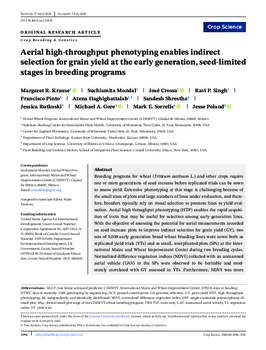Mostrar el registro sencillo del ítem
Aerial high‐throughput phenotyping enables indirect selection for grain yield at the early generation, seed‐limited stages in breeding programs
| Creador: | Krause, M. |
| Creador: | Mondal, S. |
| Creador: | Crossa, J. |
| Creador: | Singh, R.P. |
| Creador: | Pinto Espinosa, F. |
| Creador: | Haghighattalab, A. |
| Creador: | Shrestha, S. |
| Creador: | Rutkoski, J. |
| Creador: | Gore, M.A. |
| Creador: | Sorrells, M.E. |
| Creador: | Poland, J.A. |
| Año: | 2020 |
| URI: | https://hdl.handle.net/10883/21031 |
| Lenguaje: | English |
| Editor: | Crop Science Society of America (CSSA) |
| Copyright: | CIMMYT manages Intellectual Assets as International Public Goods. The user is free to download, print, store and share this work. In case you want to translate or create any other derivative work and share or distribute such translation/derivative work, please contact CIMMYT-Knowledge-Center@cgiar.org indicating the work you want to use and the kind of use you intend; CIMMYT will contact you with the suitable license for that purpose |
| Tipo: | Article |
| Lugar de publicación: | USA |
| Páginas: | 3096-3114 |
| Número: | 6 |
| Volumen: | 60 |
| DOI: | 10.1002/csc2.20259 |
| Descripción: | Breeding programs for wheat (Triticum aestivum L.) and other crops require one or more generations of seed increase before replicated trials can be sown to assess yield. Extensive phenotyping at this stage is challenging because of the small sizes of plots and large numbers of lines under evaluation, and therefore, breeders typically rely on visual selection to promote lines to yield evaluation. Aerial high‐throughput phenotyping (HTP) enables the rapid acquisition of traits that may be useful for selection among early generation lines. With the objective of assessing the potential for aerial measurements recorded on seed increase plots to improve indirect selection for grain yield (GY), two sets of 1,008 early generation bread wheat breeding lines were sown both as replicated yield trials (YTs) and as small, unreplicated plots (SPs) at the International Maize and Wheat Improvement Center during two breeding cycles. Normalized difference vegetation indices (NDVI) collected with an unmanned aerial vehicle (UAV) in the SPs were observed to be heritable and moderately correlated with GY assessed in YTs. Furthermore, NDVI was more predictive of GY than univariate genomic selection (GS), with still higher overall predictive abilities from multitrait approaches. A related experiment showed that selection based on NDVI would have outperformed visual selection, though this approach would have driven a directional response in phenology because of confounding between phenology, NDVI, and GY. A restricted selection index was proposed to address this issue. These results provide a promising outlook for the use of aerial HTP to improve selection at the early generation, seed‐limited stages of breeding programs. |
| Agrovoc: | PLANT BREEDING |
| Agrovoc: | SELECTION |
| Agrovoc: | SEED |
| Agrovoc: | PHENOTYPES |
| Agrovoc: | WHEAT |
| Datasets relacionados: | http://hdl.handle.net/11529/10548379 |
| ISSN: | 1435-0653 |
| Revista: | Crop Science |
Ficheros en el ítem
Este ítem aparece en la(s) siguiente(s) colección(ones)
-
Wheat
Wheat - breeding, phytopathology, physiology, quality, biotech

